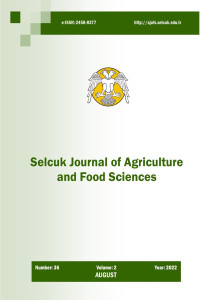Effectiveness of Conventional and Minimized Tillage Practices on Soil Quality Properties and Maize Yield Attributes
Öz
The effects of tillage systems on soil properties and crop productivity have been the subject of many studies to ensure sustainable productivity. Aims: In the study, the effects of different tillage methods applied in the intermediate period of wheat-maize rotation on the soil quality properties and corn yield elements were investigated in the pre-planting period (PP) and plant growth period (PGP) of corn. Methods: Conventional tillage (CT), minimum tillage with subsoiling and chisel (MT1), minimum tillage with subsoiling (MT2), minimum tillage with chisel (MT3) and direct sowing (DS) methods were compared. As a result of the tillage practices, at 0-20 cm, the highest bulk density values were measured in the DS and CT methods, and 20-40 cm was determined in the CT method.
The penetration resistance values of the soils measured at a depth of 0-80 cm were significantly affected by the applications made in both PP and PGP. The highest saturation value was measured in the MT3, the highest field capacity and plant available water contents were measured in the DS. The effects of the applications on the chemical properties of the soil and the nutrient content of the
corn plant were limited. The effects on only grain protein ratio from yield components of corn plant were significant, the highest value was measured in CT. Considering the sustainable management of soils labour requirement and lower costs it was concluded that DS and MT methods are more applicable than CT methods in terms of yield.
Anahtar Kelimeler
Conventional tillage Minumum tillage Direct sowing Soil water content Maize yield components
Ayrıntılar
| Birincil Dil | İngilizce |
|---|---|
| Konular | Toprak Bilimi ve Ekolojisi |
| Bölüm | Araştırma Makalesi |
| Yazarlar | |
| Yayımlanma Tarihi | 25 Aralık 2022 |
| Gönderilme Tarihi | 15 Ağustos 2022 |
| Yayımlandığı Sayı | Yıl 2022 Cilt: 36 Sayı: 3 |
Kaynak Göster
Selcuk Journal of Agriculture and Food Sciences Creative Commons Atıf-GayriTicari 4.0 Uluslararası Lisansı (CC BY NC) ile lisanslanmıştır.

